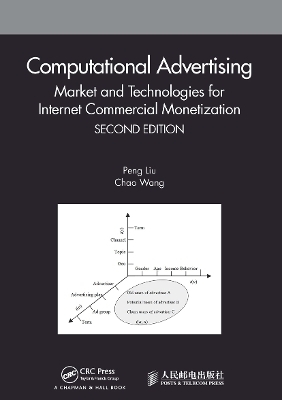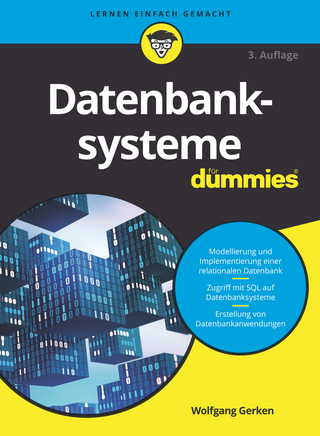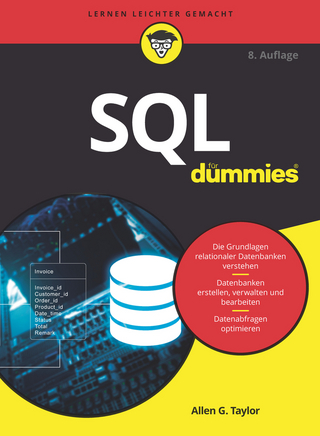
Computational Advertising
CRC Press (Verlag)
978-1-032-24140-1 (ISBN)
This book introduces computational advertising, and Internet monetization. It provides a macroscopic understanding of how consumer products in the Internet era push user experience and monetization to the limit. Part One of the book focuses on the basic problems and background knowledge of online advertising. Part Two targets the product, operations, and sales staff, as well as high-level decision makers of the Internet products. It explains the market structure, trading models, and the main products in computational advertising. Part Three targets systems, algorithms, and architects, and focuses on the key technical challenges of different advertising products.
Features
· Introduces computational advertising and Internet monetization
· Covers data processing, utilization, and trading
· Uses business logic as the driving force to explain online advertising products and technology advancement
· Explores the products and the technologies of computational advertising, to provide insights on the realization of personalization systems, constrained optimization, data monetization and trading, and other practical industry problems
· Includes case studies and code snippets
Dr. Liu Peng is senior director and chief architect of business products at Qihoo 360. He is also responsible for product and engineering for monetization of 360. After receiving his PhD from Tsinghua University in 2005, he joined Microsoft Research Asia and studied cutting-edge artificial intelligence technologies. In 2009, he participated in the founding of Yahoo! Labs Beijing as a senior scientist. He was also chief scientist of MediaV. Dr. Liu Peng is devoted to products and technologies related to big data and computational advertising. His public online course “computational advertising” has attracted more than 30,000 students on Netease.com, and has been adopted as a basic training material in many related companies. Moreover, this course has been selected by Peking University, Tsinghua University and Beihang University for their graduates. Wang Chao received his master’s degree from Peking University, and then worked at Weibo and Autohome’s advertising department for some years. He is now a tech leader in the query recommendation group at Baidu’s portal search department. His work focuses on machine learning algorithms in computational advertising, and he has won 7th place among 718 participants in “predict click-through rates on display ads” organized by Kaggle and Criteo. He is also interested in contributing code for open source machine learning tools such as xgboost.
Contents
Figures, xxi
Tables, xxvii
Foreword, xxix
Preface (1), xxxvii
Preface (2), xxxix
Preface (3), xli
Authors, xliii
PART 1 Market and Background of Online Advertising 1
CHAPTER 1 ¦ Overview of Online Advertising 3
1.1 FREE MODE AND CORE ASSETS OF THE INTERNET 4
1.2 RELATIONSHIP BETWEEN BIG DATA AND ADVERTISING 5
1.3 DEFINITION AND PURPOSE OF ADVERTISING 8
1.4 PRESENTATION FORMS OF ONLINE ADVERTISING 10
1.5 BRIEF HISTORY OF ONLINE ADVERTISING 18
CHAPTER 2 ¦ Basis for Computational Advertising 25
2.1 ADVERTISING EFFECTIVENESS THEORY 26
2.2 TECHNICAL FEATURES OF THE INTERNET ADVERTISING 29
2.3 CORE ISSUE OF COMPUTATIONAL ADVERTISING 30
2.3.1 Breakdown of Advertising Return 32
2.3.2 Relationship between Billing Models and eCPM Estimation 33
2.4 BUSINESS ORGANIZATIONS IN THE ONLINE ADVERTISING
INDUSTRY 36
2.4.1 Interactive Advertising Bureau 37
2.4.2 American Association of Advertising Agencies 38
2.4.3 Association of National Advertisers 38
PART 2 Product Logic of Online Advertising 39
CHAPTER 3 ¦ Overview of Online Advertising Products 41
3.1 DESIGN PHILOSOPHY FOR COMMERCIAL PRODUCTS 43
3.2 PRODUCT INTERFACE OF ADVERTISING SYSTEM 44
3.2.1 Demand-Side Management Interface 44
3.2.2 Supply-Side Management Interface 47
3.2.3 Multiple Forms of Interface between Supply and Demand Sides 48
CHAPTER 4 ¦ Agreement-Based Advertising 51
4.1 AD SPACE AGREEMENT 52
4.2 AUDIENCE TARGETING 53
4.2.1 Overview of Audience Targeting Technologies 54
4.2.2 Audience Targeting Tag System 57
4.2.3 Design Principles for Tag System 59
4.3 DISPLAY QUANTITY AGREEMENT 60
4.3.1 Traffic Forecasting 61
4.3.2 Traffic Shaping 61
4.3.3 Online Allocation 62
4.3.4 Product Cases 63
4.3.4.1 Yahoo! GD 63
CHAPTER 5 ¦ Search Ad and Auction-Based Advertising 65
5.1 SEARCH AD 67
5.1.1 Products of Search Advertising 67
5.1.2 New Forms of Search Ads 70
5.1.3 Product Strategy of Search Advertising 73
5.1.4 Product Cases 76
5.2 POSITION AUCTION AND MECHANISM DESIGN 79
5.2.1 Market Reserve Price 80
5.2.2 Pricing Problem 81
5.2.3 Squashing 83
5.2.4 Myerson Optimal Auction 84
5.2.5 Examples of Pricing Results 85
5.3 AUCTION-BASED ADN 85
5.3.1 Forms of ADN Products 86
5.3.2 Product Strategy for ADN 88
5.3.3 Product Cases 89
5.4 DEMAND-SIDE PRODUCTS IN AUCTION-BASED ADVERTISING 90
5.4.1 Search Engine Marketing 90
5.4.2 Trading Desk 91
5.4.3 Product Cases 91
5.5 COMPARISON BETWEEN AUCTION-BASED AND
AGREEMENT-BASED ADVERTISING 93
CHAPTER 6 ¦ Programmatic Trade Advertising 95
6.1 RTB 97
6.1.1 RTB Process 98
6.2 OTHER MODES OF PROGRAMMED TRADE 100
6.2.1 Preferred Deal 100
6.2.2 Private Marketplace 101
6.2.3 Programmatic Direct Buy 102
6.2.4 Spectrum of Advertising Transactions 103
6.3 AD EXCHANGE 104
6.3.1 Product Samples 104
6.4 DEMAND-SIDE PLATFORM 105
6.4.1 DSP Product Strategy 106
6.4.2 Bidding Strategy 106
6.4.3 Bidding and Pricing Processes 108
6.4.4 Retargeting 108
6.4.5 Look-Alike 111
6.4.6 Product Cases 112
6.5 SUPPLY-SIDE PLATFORM 113
6.5.1 SSP Product Strategy 114
6.5.2 Header Bidding 115
6.5.3 Product Cases 117
CHAPTER 7 ¦ Data Processing and Exchange 119
7.1 VALUABLE DATA SOURCES 120
7.2 DATA MANAGEMENT PLATFORM 123
7.2.1 Tripartite Data Partitioning 123
7.2.2 First-Party DMP 123
7.2.3 Third-Party DMP 124
7.2.4 Product Cases 125
7.3 BASIC PROCESS OF DATA TRADING 129
7.4 PRIVACY PROTECTION AND DATA SECURITY 131
7.4.1 Privacy Protection 131
7.4.2 Data Security in Programmatic Trade 134
7.4.3 General Data Protection Regulations 136
CHAPTER 8 ¦ News Feed Ad and Native Ad 139
8.1 STATUS QUO AND CHALLENGES IN MOBILE ADVERTISING 140
8.1.1 Characteristics of Mobile Advertising 141
8.1.2 Traditional Creative of Mobile Advertising 142
8.1.3 Challenges in Front of Mobile Advertising 144
8.2 NEWS FEED AD 146
8.2.1 Definition of News Feed Ad 146
8.2.2 Key Points about News Feed Ad 149
8.3 OTHER NATIVE AD-RELATED PRODUCTS 150
8.3.1 Search Ad 150
8.3.2 Advertorial 151
8.3.3 Affiliate network 151
8.4 NATIVE ADVERTISING PLATFORM 151
8.4.1 Native Display and Native Scenario 152
8.4.2 Scenario Perception and Application 153
8.4.3 Product Placement Native Ad 154
8.4.4 Product Cases 157
8.5 NATIVE AD AND PROGRAMMATIC TRADE 161
PART 3 Key Technologies for Computational Advertising 163
CHAPTER 9 ¦ Technological Overview 165
9.1 PERSONALIZED SYSTEM FRAMEWORK 166
9.2 OPTIMIZATION GOALS OF VARIOUS ADVERTISING SYSTEMS 167
9.3 COMPUTATIONAL ADVERTISING SYSTEM ARCHITECTURE 169
9.3.1 Ad Serving Engine 169
9.3.2 Data Highway 172
9.3.3 Offline Data Processing 172
9.3.4 Online Data Processing 173
9.4 MAIN TECHNOLOGIES FOR COMPUTATIONAL
ADVERTISING SYSTEM 174
9.5 BUILD A COMPUTATIONAL ADVERTISING SYSTEM WITH
OPEN SOURCE TOOLS 175
9.5.1 Web Server Nginx 176
9.5.2 ZooKeeper: Distributed Configuration and Cluster
Management Tool 178
9.5.3 Lucene: Full-Text Retrieval Engine 179
9.5.4 Thrift: Cross-Language Communication Interface 179
9.5.5 Data Highway 180
9.5.6 Hadoop: Distributed Data-Processing Platform 181
9.5.7 Redis: Online Cache of Features 182
9.5.8 Strom: Stream Computing Platform Storm 182
9.5.9 Spark: Efficient Iterative Computing Framework 183
CHAPTER 10 ¦ Fundamental Knowledge 185
10.1 INFORMATION RETRIEVAL 186
10.1.1 Inverted Index 186
10.1.2 Vector Space Model 189
10.2 OPTIMIZATION 190
10.2.1 Lagrange Multiplier and Convex Optimization 191
10.2.2 Downhill Simplex Method 192
10.2.3 Gradient Descent 193
10.2.4 Quasi-Newton Methods 195
10.2.5 Trust Region Method 199
10.3 STATISTICAL MACHINE LEARNING 201
10.3.1 Maximum Entropy and Exponential Family Distribution 202
10.3.2 Mixture Model and EM Algorithm 204
10.3.3 Bayesian Learning 206
10.4 DISTRIBUTED OPTIMIZATION FRAMEWORK FOR
STATISTICAL MODEL 210
10.5 DEEP LEARNING 211
10.5.1 DNN Optimization Methods 212
10.5.2 Convolutional Neural Network 214
10.5.3 Recursive Neural Network 215
10.5.4 Generative Adversarial Nets 217
CHAPTER 11 ¦ Agreement-Based Advertising Technologies 219
11.1 ADVERTISING SCHEDULING SYSTEM 220
11.1.1 Scheduling and Mixed Ad Serving 220
11.2 GD SYSTEM 221
11.2.1 Traffic Forecasting 222
11.2.2 Frequency Capping 224
11.3 ONLINE ALLOCATION 227
11.3.1 Online Allocation Problem 228
11.3.2 Examples of Online Allocation Problems 230
11.3.3 Limit Performance Analysis 232
11.3.4 Practical Optimization Algorithms 233
11.4 HEURISTIC ALLOCATION PLAN HWM 240
CHAPTER 12 ¦ Audience-Targeting Technologies 245
12.1 CLASSIFICATION OF AUDIENCE TARGETING TECHNOLOGIES 246
12.2 CONTEXTUAL TARGETING 248
12.2.1 Near-Line Crawling System 249
12.3 TEXT TOPIC MINING 250
12.3.1 LSA Model 250
12.3.2 PLSI Model 251
12.3.3 LDA Model 252
12.3.4 Word Embedding (Word2vec) 253
12.4 BEHAVIORAL TARGETING 255
12.4.1 Modeling Problem for Behavioral Targeting 255
12.4.2 Feature Generation for Behavioral Targeting 257
12.4.2.1 Tagging Methods for Various Behaviors 260
12.4.3 Decision-making Process for Behavioral Targeting 261
12.4.4 Evaluation of Behavioral Targeting 262
12.5 PREDICTION OF DEMOGRAPHICAL ATTRIBUTES 264
12.6 DATA MANAGEMENT PLATFORM 266
CHAPTER 13 ¦ Auction-Based Advertising Technologies 267
13.1 PRICING ALGORITHMS IN AUCTION-BASED ADVERTISING 268
13.2 SEARCH AD SYSTEM 270
13.2.1 Query Expansion 272
13.2.2 Ad Placement 274
13.3 ADN 275
13.3.1 Short-Term Behavior Feedback and Stream Computing 275
13.4 AD RETRIEVAL 278
13.4.1 Boolean Expression 279
13.4.2 Relevance Retrieval 283
13.4.3 DNN-Based Semantic Modeling 288
13.4.4 ANN Semantic Retrieval 292
CHAPTER 14 ¦ CTR Prediction Model 301
14.1 CTR PREDICTION 302
14.1.1 CTR Basic Model 302
14.1.2 LR Model-Based Optimization Algorithm 303
14.1.3 Correction of CTR Model 312
14.1.4 Features of CTR Model 313
14.1.5 Evaluation of CTR Model 319
14.1.6 Intelligent Frequency Capping 321
14.2 OTHER CTR MODELS 322
14.2.1 Factorization Machines 322
14.2.2 GBDT 323
14.2.3 Deep Learning-Based CTR Model 324
14.3 EXPLORATION AND UTILIZATION 326
14.3.1 Reinforcement Learning and E&E 327
14.3.2 UCB 329
14.3.3 Contextual Bandit 329
CHAPTER 15 ¦ Programmatic Trade Technologies 331
15.1 ADX 332
15.1.1 Cookie Mapping 334
15.1.2 Call-out Optimization 336
15.2 DSP 338
15.2.1 Customized User Segmentation 340
15.2.1.1 Look-Alike Modeling 341
15.2.2 CTR Prediction in DSP 342
15.2.3 Estimation of Click Value 343
15.2.4 Bidding Strategy 344
15.3 SSP 345
15.3.1 Network Optimization 346
CHAPTER 16 ¦ Other Advertising Technologies 347
16.1 CREATIVE OPTIMIZATION 348
16.1.1 Programmatic Creative 349
16.1.2 Click Heat Map 350
16.1.3 Trend of Creative 351
16.2 EXPERIMENTAL FRAMEWORK 353
16.3 ADVERTISING MONITORING AND ATTRIBUTION 354
16.3.1 Ad Monitoring 355
16.3.2 Ad Safety 356
16.3.3 Attribution of Advertising Performance 357
16.4 SPAM AND ANTI-SPAM 359
16.4.1 Classification of Spam Methods 359
16.4.2 Common Ad Spam Methods 360
16.5 PRODUCT AND TECHNOLOGY SELECTION 366
16.5.1 Best Practices for Media 367
16.5.2 Best Practices for Advertisers 370
16.5.3 Best Practices for Data Providers 372
PART 4 Terminology and Index 375
REFERENCES, 381
INDEX, 387
| Erscheinungsdatum | 14.12.2021 |
|---|---|
| Zusatzinfo | 131 Illustrations, black and white |
| Verlagsort | London |
| Sprache | englisch |
| Maße | 178 x 254 mm |
| Gewicht | 453 g |
| Themenwelt | Mathematik / Informatik ► Informatik ► Datenbanken |
| Sozialwissenschaften ► Kommunikation / Medien ► Journalistik | |
| Wirtschaft ► Betriebswirtschaft / Management ► Marketing / Vertrieb | |
| ISBN-10 | 1-032-24140-3 / 1032241403 |
| ISBN-13 | 978-1-032-24140-1 / 9781032241401 |
| Zustand | Neuware |
| Informationen gemäß Produktsicherheitsverordnung (GPSR) | |
| Haben Sie eine Frage zum Produkt? |
aus dem Bereich


